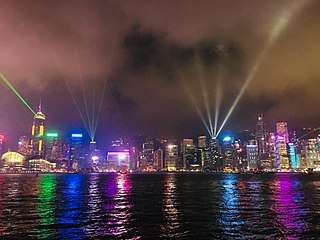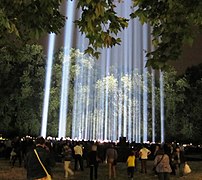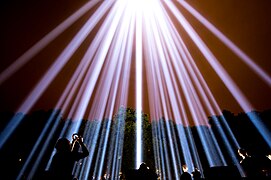
The Tribute in Light is an art installation created in remembrance of the September 11 attacks. It consists of 88 vertical searchlights arranged in two columns of light to represent the Twin Towers. It stands six blocks south of the World Trade Center on top of the Battery Parking Garage in New York City. Tribute in Light began as a temporary commemoration of the attacks in early 2002, but it became an annual event, currently produced on September 11 by the Municipal Art Society of New York. The Tribute in Light was conceived by artists John Bennett, Gustavo Bonevardi, Richard Nash Gould, Julian LaVerdiere, and Paul Myoda, and lighting consultant Paul Marantz.

A searchlight is an apparatus that combines an extremely bright source with a mirrored parabolic reflector to project a powerful beam of light of approximately parallel rays in a particular direction. It is usually constructed so that it can be swiveled about. The most common element used in modern searchlights is Xenon (Xe). However, Rare-earth elements such as lanthanum (La) and cerium (Ce) are used in phosphors to improve light quality in some specialized searchlights.

An arc lamp or arc light is a lamp that produces light by an electric arc.

A headlamp is a lamp attached to the front of a vehicle to illuminate the road ahead. Headlamps are also often called headlights, but in the most precise usage, headlamp is the term for the device itself and headlight is the term for the beam of light produced and distributed by the device.

Ryoji Ikeda is a Japanese visual and sound artist who currently lives and works in Paris, France. Ikeda's music is concerned primarily with sound in a variety of "raw" states, such as sine tones and noise, often using frequencies at the edges of the range of human hearing. Rhythmically, Ikeda's music is highly imaginative, exploiting beat patterns and, at times, using a variety of discrete tones and noise to create the semblance of a drum machine. His work also encroaches on the world of ambient music and lowercase; many tracks on his albums are concerned with slowly evolving soundscapes, with little or no sense of pulse.

A xenon arc lamp is a highly specialized type of gas discharge lamp, an electric light that produces light by passing electricity through ionized xenon gas at high pressure. It produces a bright white light to simulate sunlight, with applications in movie projectors in theaters, in searchlights, and for specialized uses in industry and research. For example, Xenon arc lamps and mercury lamps are the two most common lamps used in wide-field fluorescence microscopes.

A motor vehicle has lighting and signaling devices mounted to or integrated into its front, rear, sides, and, in some cases, top. Various devices have the dual function of illuminating the road ahead for the driver, and making the vehicle visible to others, with indications to them of turning, slowing or stopping, etc., with lights also indicating the size of some large vehicles.

A Symphony of Lights is a daily light and sound show across the Victoria Harbour in Hong Kong. It is the world's largest permanent light and sound show, according to Guinness World Records. As of 2017, there were 42 participating buildings in the show.
Constantine Koukias is a Tasmanian composer and opera director of Greek ancestry based in Amsterdam, where he is known by his Greek name of Konstantin Koukias. He is the co-founder and artistic director of IHOS Music Theatre and Opera, which was established in 1990 in Tasmania's capital city, Hobart.
Tony Oursler is an American multimedia and installation artist married to Jacqueline Humphries. He completed a Bachelor of Fine Arts at the California Institute for the Arts, Valencia, California, in 1979. His art covers a range of mediums, working with video, sculpture, installation, performance, and painting. He lives and works in New York City.

The Cathedral of Light or Lichtdom was a main aesthetic feature of the Nazi Party rallies in Nuremberg from 1934 to 1938. Designed by architect Albert Speer, it consisted of 152 anti-aircraft searchlights, at intervals of 12 metres, aimed skyward to create a series of vertical bars surrounding the audience. The Cathedral of Light was documented in the Nazi propaganda film Festliches Nürnberg, released in 1937.

The Imagine Peace Tower is a memorial to John Lennon from his widow, Yoko Ono, located on Viðey Island in Kollafjörður Bay near Reykjavík, Iceland. Installed in 2007, it consists of a tall tower of light, projected from a white stone monument that has the words "Imagine Peace" carved into it in 24 languages. These words, and the name of the tower, are a reference to Lennon's campaign for peace, and his 1971 song "Imagine".
Mona Foma, stylised as MONA FOMA was an annual music and arts festival held in Tasmania, Australia, curated by Violent Femmes member Brian Ritchie. Recognised as Tasmania's largest contemporary music festival, it featured a broad range of artistic genres, including sound, noise, dance, theatre, visual art, performance, and new media.

The Museum of Old and New Art (MONA) is an art museum located within the Moorilla winery on the Berriedale peninsula in Hobart, Tasmania, Australia. It is the largest privately funded museum in the Southern Hemisphere. MONA houses ancient, modern and contemporary art from the David Walsh collection. Noted for its central themes of sex and death, the museum has been described by Walsh as a "subversive adult Disneyland".

Walter D'Arcy Ryan was an influential early lighting engineer who worked for General Electric as director of its Illuminating Engineering Laboratory. He pioneered skyscraper illumination, designed the Scintillator colored searchlights display, and was responsible for the lighting of the Panama–Pacific International Exposition in San Francisco and the Century of Progress Exposition in Chicago, in addition to the first complete illumination of Niagara Falls. He combined illumination into both an art and a science.
Chris Levine is a light artist with a multi-disciplinary approach that harnesses a diverse array of technology with the intention of revealing the ways in which light is fundamental to human experience. Levine uses a cross-disciplinary approach working across many fields including music, performance, installation, fashion, and design in a multitude of collaborative projects. He has worked with a wide range of collaborators, including Antony and the Johnsons, Philip Treacy, Massive Attack, Grace Jones, Asprey Jewelers, BMW, Absolute Vodka, Mario Testino and has an ongoing relationship with The Eden Project. Levine is driven by a deep-rooted desire to expand perception and guide the viewer to a meditative engagement with the present moment. His portraits are internationally recognised but he is not a portrait artist in the traditional sense. Levine is known for creating the Lightness of Being and Equanimity, both portraits of Queen Elizabeth II. Equanimity was commissioned by the Jersey Heritage Trust in 2004 and on 1 June 2012, a £100 note was issued to commemorate the Diamond Jubilee of Queen Elizabeth II based on the portrait. At the heart of Levine's practice are his immersive light Installation art projects in which he has endeavoured to take art out of the gallery environment into a real world, mass participatory experience.

Dark Mofo is an annual mid-winter arts and culture festival held by the Museum of Old and New Art (MONA) in Hobart, Tasmania, Australia. Launched in 2013 as the winter counterpart of the summer MONA FOMA festival, Dark Mofo events take place at night and celebrate the darkness of the southern winter solstice, featuring many musical acts, large scale light installations and a winter feast.
14–18 NOW was the UK's arts programme for the First World War centenary. Working with arts and heritage partners all across the UK, the programme commissioned new artworks from 420 contemporary artists, musicians, filmmakers, designers and performers, inspired by the period 1914–1918.

The Odeon Theatre is a historic former cinema and current live entertainment venue in the city of Hobart, Tasmania, Australia.

Michaela Gleave is a Sydney-based Australian conceptual artist best known for her use of light and her monumental site specific art works engaging with space, time and matter. She was a 2012-2013 artist-in-residence at CSIRO Astronomy and Space Science and won a churchie award in 2015.
![spectra [london], 2014. The beam could be seen for miles above the rooftops and chimneys of London. Spectra above chimney tops.png](http://upload.wikimedia.org/wikipedia/en/thumb/d/d5/Spectra_above_chimney_tops.png/170px-Spectra_above_chimney_tops.png)
![spectra [tasmania] pierces the Hobart Skyline, 22 June 2013. Spectra & Full Moon from Mt Wellington (9111132653).jpg](http://upload.wikimedia.org/wikipedia/commons/thumb/7/7b/Spectra_%26_Full_Moon_from_Mt_Wellington_%289111132653%29.jpg/220px-Spectra_%26_Full_Moon_from_Mt_Wellington_%289111132653%29.jpg)



















